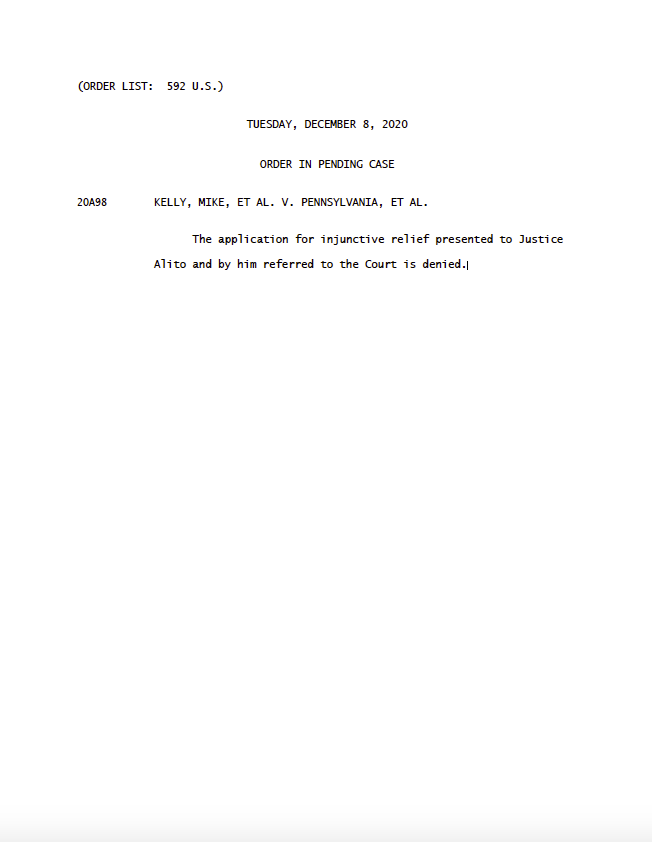The rare nested triple passive, courtesy of the US Supreme Court

In a one-sentence ruling, the Supreme Court of the United States rejected the Trump administration’s plea to overturn the election result in Pennsylvania. But what a sentence!
The background: U.S. Representative Mike Kelly of Pennsylvania filed a document to overturn the decision of the Pennsylvania Supreme Court and nullify the election result in Pennsylvania, where Biden won. He applied for relief in the form of an injunction, that is, a ruling that compels action immediately.
Here’s the Supreme Court’s ruling, in full:
TUESDAY, DECEMBER 8, 2020
ORDER IN PENDING CASE
20A98 KELLY, MIKE, ET AL. V. PENNSYLVANIA, ET AL.
The application for injunctive relief presented to Justice Alito and by him referred to the Court is denied.
Let’s unwind that sentence
Normally, I’d praise the court for the brevity of a one-sentence ruling. But, as my son accurately described it, this sentence is a “matryoshka doll of passive voice.” We can check for passives using the “zombies test,” seeing if the sentence still makes sense if we put “by zombies” after each of the verbs (presented, referred, denied).
The application for injunctive relief presented to Justice Alito by zombies and by him referred to the Court is denied by zombies.
(There’s no need for the zombies test for “referred” since it already has a “by” phrase: “by him.”)
Sure enough, all three verbs are passive. This means that to make the sentence active, we must not only convert three verbs, but also answer three “Who did it?” questions, one for each verb.
- Who presented the application for injunctive relief to Justice Alito? Representative Mike Kelly.
- Who referred the application to the Court? Justice Alito.
- Who denied the application? The Supreme Court (unanimously).
The next step in reconstructing the sentence is to rewrite each part using the same verbs in active voice.
Representative Kelly presented the case to Justice Alito for injunctive relief. Justice Alito referred it to the Court. The Court denied it.
That tells the story clearly, but there is some repetition, specifically of Justice Alito. Can we do what the Court intended, and deliver the result briefly in a sentence, but this time in active voice? Here’s one way to do it.
The Court denies Representative Mike Kelly’s application for injunctive relief, which he had presented to Justice Alito, who subsequently referred it to the Court.
This isn’t as satisfactory as I’d hope. It puts the denial up front where it belongs (it is, after all, the most important result) and stuffs the supporting information into subordinate clauses. But at least it tells who did what.
Often you can do better by changing the verbs. Here’s a try at that:
The Court denies the application for injunctive relief that Justice Alito received from Representative Mike Kelly and subsequently referred to the Court.
Imagine if the Supreme Court allowed itself to speak in the first person plural. You might get something clearer, like this.
We received and denied the application for injunctive relief that Representative Mike Kelly presented to Justice Alito, who subsequently referred it to us.
Or this, even simpler:
We received the application for injunctive relief that Representative Mike Kelly sent to Justice Alito, who forwarded it to us, and we’ve denied it.
This is not as absurd an exercise as it might seem
Courts seem to write in the passive voice, because it implies that their decisions just are, as opposed to revealing the truth, which is that human beings on the court are making choices.
But there’s still a lesson to be learned here. Passive voice is not a simple problem to fix, like adding an apostrophe you forgot. It raises questions about who did what, what verbs are best, and what belongs at the front of the sentence. It shouldn’t surprise us that untangling a nested triple passive sentence requires some effort.
When you attempt to rewrite sentences in active voice, you learn things. You have to figure out who is acting and what is important to communicate. You may decide to rewrite the passage entirely. If you’re smart about that effort, the results will be much clearer. The reason for that is that passive voice is easy for lazy writers to spew out, while active voice demands a bit more thought about what’s actually happening and who is doing it. And that’s a good reason to take the effort to make your writing more active.
(Actual ruling below.)

The Court’s opinion could have been simply “Ain’t gonna happen, Donald.”
So if I use your “by zombies” test for passive voice, I count only two, not three, in the Supreme Court’s sentence. The sentence does too answer the question of who referred Representative Kelly’s application to the Court. It’s “by him,” and “him” can only refer to Justice Alito since no other man (or any other person) is mentioned anywhere in the sentence.
Insert “by zombies” after “. . . and “by him referred” so that the sentence would read “. . . by him referred by zombies to the Court . . .” That simply does not make sense, and the “by zombies” test fails there.
What have I failed to understand? Thank you.
When there is a by clause in the sentence already, it takes the place of the “by zombies.” It’s still passive. You don’t need the “by zombies” if the “by somebody” is in there already.
More specifically, grammatically in this monster sentence, the subject of the verb “referred” is “application.” But the application didn’t do the referring, Alito did. When the subject of a verb is not the actor, then you have passive voice.
Thanks. That’s quite helpful.
This is one rare instance in which I actually liked and cheered the passive voice … because it is such an exquisitely polite yet passive-aggressive way for the court to tell the Trumpsters FOR GOD’S SAKE KNOCK OFF THIS INSANE STUPIDITY RIGHT THIS MINUTE AND STFU!!!!!~
The blog post regarding a triple passive presented to readers and by them commented upon is valued.
👍
Your comment is deeply appreciated by the author.
This article was both helpful and well received by zombies. Insightful work like this is always appreciated, and again, by zombies.
One imagines that a brain, so productive and insightful, must also be quite delicious.
LOL – too funny!
Great catch! I, uh, think I understand what happened. The court used 3 passive verbs to describe one action and provided an opportunity to create the rare nested triple passive!
It’s the correct way, however, to write in essay form – the application … (introduction), presented … (body) is denied (conclusion) – with as few words as possible. Of course, an active voice describing one act could simply have said, “We deny the application” – and many such SCOTUS decisions have been written.